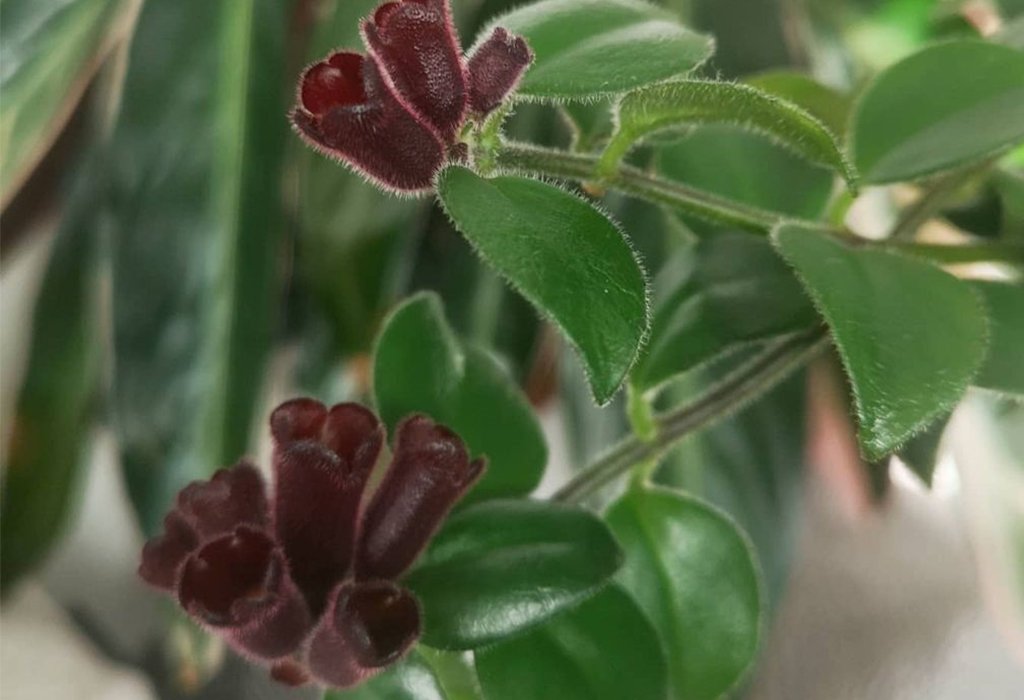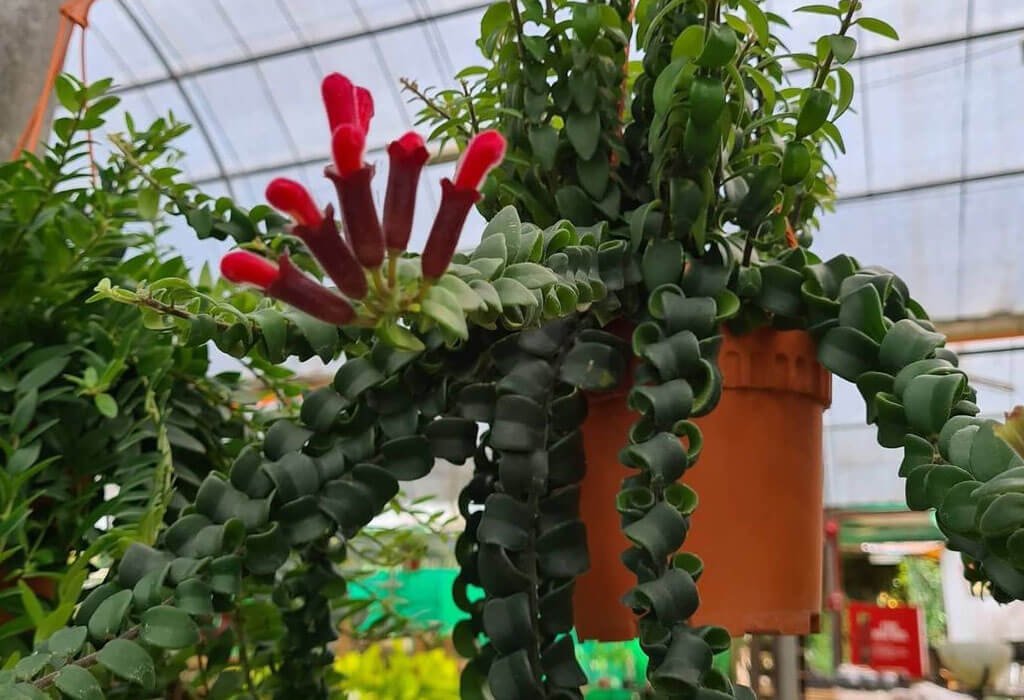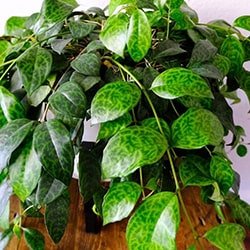Are you searching for a plant with unique leaves and flowers, then you are right with a lipstick plant. Nowadays, the lipstick plant is very famous as a house plant. This plant gets a lipstick name due to the flower buds peek out of dark-coloured tubes, trying sort of a miniature tube of lipstick.
This tropical plant life puts on a stunning show ahead of a bright window and is a wonderful selection for adding a splash of colour to bright bathrooms, eating rooms and lit kitchens.
Lipstick plants are simple, care indoor flowering houseplants. When correctly cared for and mature in proper conditions, lipstick plant vines will grow 2 to 3 feet in height.
What is a lipstick plant Aeschynanthus?
This is a genus of endless subtropical and tropical plants in the “Gesneriaceae family“.
Aeschynanthus is a flowering plant life with bright red flowers and glossy inexperienced leaves.
Different names:
Another name of this plant is Lipstick Vine.
The Botanical Name of this plant is Aeschynanthus pulcher.
Origin (History) of lipstick plant
Aeschynanthus radicans, usually known as Lipstick Radicand or lipstick vascular plant, is an epiphytic evergreen vascular plant from Malaysia with slender trailing and arced stems originating in tree branches.
It’s long, red, hollow flowers in dense terminal clusters.
What we do before growing?
Choose a place which gets medium to bright spot. Choose a soil which is general potting soil.
Leaves and flowers
How to Propagate Lipstick Plant

For best lipstick plant propagation, follow the below steps of planting.
- Choose the right time:
The Lipstick plant will best grow in spring time.
- Choose the right spot:
The Lipstick plant will easily grow in a pot or container. Lipstick vine is also growing in the garden area and pot or container.
- Soil Selection Matters:
Lipstick plants would like soil that’s systematically damp, however well-draining. Grow lipstick plant in a very bright location far from direct daylight. Lipstick plants do not need any special soil and can typically grow simply fine, normally potting soil.
Flower Blooming
When will a lipstick plant flower? The lipstick plant typically blooms throughout the late summer and early fall; however, it will bloom throughout the year. Mine continues to bloom on and off all winter, and it’s one in every of my favorite winter flowering plants.
Sunlight
How much sun does this plant need? The lipstick vascular plant won’t bloom while not adequately lightweight.
Avoid putting lipstick plant full shade or full sun. This plant desires bright, lightweight for a little of the day, however not all day long.
How deep to plant?
Make 1.7 in. Deep holes within the soil and place the cut end of the lipstick plant.
Watering
How much water does the lipstick plant need? The Lipstick Plant’s growth slows, thus, so it needs less water. You may most likely solely get to water once every two weeks.
Lipstick Plant Care

Watering
These plants flower a lot frequently and extravagantly if you permit the highest 30% of the soil to dry out before watering. If the leaves of a lipstick plant seem soft and faded, offer the plant a lot of water. These plants lose inexperienced leaves once they are over-watered.
Water lipstick plant enough to stay the soil wet, however, not wet or saturated for extended periods. Do not let lipstick plant wilt; however, additionally, pay attention not to overwater it. If this plant stays too wet, it’ll suffer from plant disease.
During the active season, you’ll need to water a median of once weekly.
Throughout the cooler months of the year, the Lipstick Plant’s growth slows; thus, it needs less water. You may, in all probability, solely have to be compelled to water once each 2 to 3 weeks.
Amount of sunlight
The lipstick plant won’t bloom while not adequately lightweight. Avoid inserting this plant in full shade or full sun. The plant wants bright, lightweight for a little of the day, however not all day long.
This plant wants bright, indirect lightweight. It shouldn’t be placed in an exceeding position in full sun as this may scorch the leaves; however, if it doesn’t get enough lightweight, it’ll struggle to own the energy to provide flowers. Aim for around six hours of indirect lightweight daily.
How to prune lipstick plant?
Prune your lipstick plant after you stop flowering.
Remove up to a simple fraction of every vascular plant if the plant appearance long and leggy. If the plant is badly overgrown, cut the longest stems right down to many inches (8 to 12 cm.) higher than the soil. However, take care to retain some fullness within the center of the plant.
Pruning can produce a lot of blooms for you to get pleasure from. A combination of scissors or hand pruners can work well and perpetually cut right on top of a leaf node.
Always certify the blades of your pruning tools are clean; therefore, you don’t transfer sickness to your lipstick plant. Wiping the blades off with lotion will the trick.
How to Report lipstick plant?
Develop the new pot or container by filling it a couple of quarters filled with a fertile, lightweight potting combine that drains well. Water the soil to assist it. Ensure the pot or container has bottom emptying. Carefully take away the lipstick plant from its gift instrumentation and examine the roots for wrapping. Gently tease any wrapping roots apart.
Set the lipstick plant within the new pot or container, adding or removing therefore so it’ll be growing at an equivalent height it’s presently. You are doing not wish to plant too deep, or issues with rot will occur. Fill the rest of the pot or container up with soil, firming it up around the lipstick plant.
Apply fertilizer
Fertilize the lipstick plant employing a soluble flora mix applied at half-strength. Throughout spring through summer, feed the lipstick plant each period.
Take the lipstick plant to the sink and permit the water to run slowly through the soil for 5 minutes, removing the salt buildup.
The leaves on your aeschynanthus turning brown could be a sign of an excessive amount of salt within the soil from the chemical.
Evaporation
If your lipstick plant isn’t growing during a hanging basket, however, during regular instrumentation, fill a receptacle up with tiny pebbles and set the pot on prime of it.
As you water, it drains from the pot into the receptacle, and because the water evaporates, it creates humidness around the lipstick plant.
Fill a sprig suppress with temperature water and mist the lipstick plant many times weekly.
The regular use of water within the area creates a damp setting for the plant.
Lipstick Plant Varieties
- Black pagoda lipstick plant.
Black pagoda lipstick plant scientific name aeschynanthus pulcher. The leaves with velvet structure in inexperienced color with black stripes, flowers color will be orange or red.
- Cassiopeia lipstick plant
This plant may be a dramatic selection that has bright red flowers that emerge from dark purple-red buds. Typically additionally known as twisted lipstick plant, the disciple has uncommon twisted leaves and wealthy red flowers.
- Tangerine lipstick plant
Tangerine lipstick plant may be a fun selection with inexperienced leaves and orange-yellow flowers. Another name is “Aeschynanthus radicans Tangerine.”
- Rasta lipstick plant
Typically additionally known as twisted lipstick plant, the disciple has uncommon twisted leaves and wealthy red flowers. Another name is “aeschynanthus radicans Rasta.”
- Mini varied lipstick plant
Mini varied lipstick plant offers medium-green leaves spattered in golden-yellow variegation and little ruddy flowers. Another name is “aeschynanthus micranthus Variegata.”
Protection Against Pests
Mealybugs:
The rubbing alcohol can kill the bugs on contact; however, it should be available in direct contact with the mealybugs so as for it to be effective.
One way to slaughter mealybugs on houseplants is by touching them with a cotton swab that’s been drenched in the application.
Aphids:
Spray the leaves of the plagued flora with a robust stream of water to launder all of the aphids you see.
Then wash the leaves with a weak resolution of gentle soap and water. Cleanser water kills aphids on contact.
Before exploitation, any form of soap resolution for aphids on your plants, check it one leaf initial to form positive the soap won’t harm the plant.
Mites:
Bring the plant to the sink or bathing tub. Then wash the leaves with home-cured pesticide soap, and rinse the leaves well to scrub away several dead mites.
After the cleanup of the leaves, exploit a range of home remedies for spider mites, and every one of them is effective for dominant plant mites inside.
Interesting Facts
- Lipstick plants are a great choice as house plants.
- The lipstick plant has shiny foliage and interesting flowers.
- The lipstick plant is not toxic to animals.
- Its leaves are waxy, green, ovate, opposite, and succulent.
- With its enticing displays of scarlet flowers, the Lipstick plant will facilitate shielding sensitive plants from the doubtless harmful effects.
Question related to Aeschynanthus plant
1. How does one lookout of a lipstick plant?
Grow aeschynanthus during a medium to a bright spot. The lot of lightweights it gets, the higher aeschynanthus can bloom. If you’ve got an aeschynanthus that will not turn out flowers, attempt moving it to a brighter spot. Water aeschynanthus enough to stay the soil wets, however, not wet or saturated for extended periods.
2. Can lipstick plants go outside?
In summer, you’ll be able to place your aeschynanthus in a shady space outdoors throughout the cold winter months. It’ll be happy growing during a south or west window. Lipstick Plants appreciate bright, robust, lightweight, however, not direct daylight. Plants that refuse to bloom merely don’t seem to be obtaining enough lightweight.
3. How usually do you have to water a lipstick plant?
These plants flower many off-times and a lot of extravagantly if you permit the highest twenty-fifth of the soil to dry out before watering. If the leaves of an aeschynanthus seem soft and faded, provide the plant a lot of water. These plants lose inexperienced leaves after they are over-watered.
4. Can lipstick grow in full sun?
No
5. Is lipstick plant an annual or perennial?
Perennial



